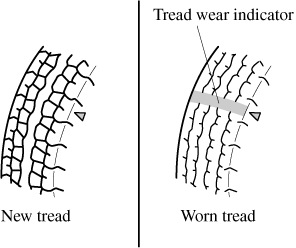

Replacing a Tyre
Always use tyres that are in good condition:
Driving with worn tyres is dangerous. Reduced braking, steering, and traction could result in an accident.
Replace all four tyres at the same time:
Replacing just one tyre is dangerous. It could cause poor handling and poor braking resulting in loss of vehicle control. Mazda strongly recommends that you replace all four tyres at the same time.
If a tyre wears evenly, a wear indicator will appear as a solid band across the tread.
Replace the tyre when this happens.

You should replace the tyre before the band crosses the entire tread.




